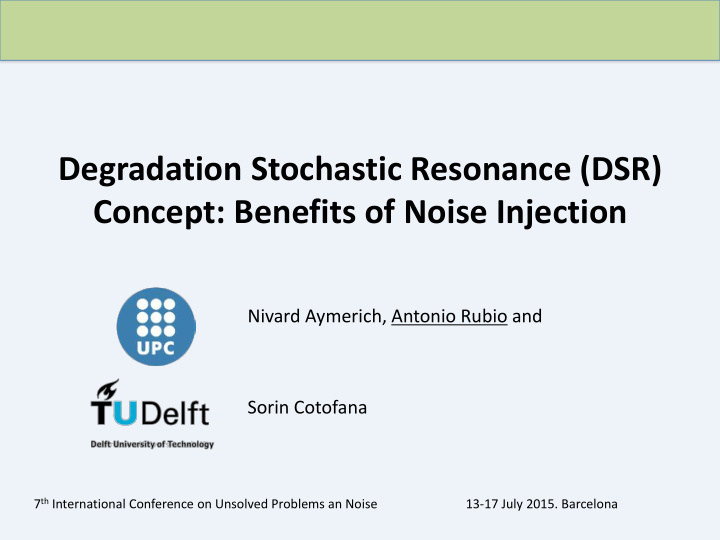



Degradation Stochastic Resonance (DSR) Concept: Benefits of Noise Injection Nivard Aymerich, Antonio Rubio and Sorin Cotofana 7 th International Conference on Unsolved Problems an Noise 13-17 July 2015. Barcelona
Both groups, we are working on the research and development of computing systems driven by noise. In this case we will emphasizes on the unconventional fact that noise may benefit the reliability of hardware. 2
OUTLINE MOTIVATION INTRODUCTION / THE ADAPTIVE AVERAGING CELL (AD-AVG) DEGRADATION STOCHASTIC RESONANCE (DSR) EFFECT BENEFITS OF INJECTING NOISE CONCLUSION 3
Motivation: Technology Evolution --- Moore ’ s Law Terascale Computing (10 12 ) Nº transistors, memory size, performance 4
Moore’s Law… Technology (455 ÷ ) 10 μ m 22nm Transistor count (2 21 × ) 2,300 4,300,000,000 Clock rate (4,730 × ) 740kHz 3.5GHz 44 years of Moore’s Law 10 μ m 22nm 2,300 tr. 4.3B tr. 740kHz 3.5GHz 1971 2015 Intel 4004 Intel Xeon E5-2600 v2 5
Scaling Limits • Fundamental: thermodynamics, quantum mechanics, electromagnetic • Material: breakdown, heat transfer, degradation • Manufacturing: lithography limits, variability 6
Situation nowadays • Variability, manufacturing limitations and degradation are causing loss of performance enhancement. Making critical the technology progress. • The manufacturing yield and lifetime is dramatically affected Need to introduce Fault Tolerance: Redundancy 7
Redundancy Design reliable systems from non-reliable components NAND multiplexing RMR CRMR Averaging Cell Reconfiguration
INTRODUCTION – THE ADATIVE AVERAGING CELL (AVG) 9
Heterogeneous-aware Reliable Design: ADAPTIVE-AVG cell AD-AVG Implementation Variability Monitor based on a disagreement detector between the AD-AVG output and the signal provided by each replica y i Averaging Scheme based on a crossbar of switching resistive devices Implements an adaptive algorithm to maximize reliability. Able to cope with non-homogeneous variability and time-varying effects. 10
DEGRADATION IMPACT ON AD-AVG noise degradation 11
MOTIVATION Analyzing the reliability of the Adaptive Averaging Cell (AD-AVG) against noise and degradation we observed that… SOMETIMES, HARDWARE DEGRADATION DOES NOT MEAN A LOSS OF RELIABILITY - AD-AVG architecture 12
INTRODUCTION – YIELD MEASUREMENT • AD-AVG YIELD = % of circuits in a MC simulation that satisfy the reliability requirement Pe < 10 −4 . σ 1 σ 2 σ R 13
Heterogeneous-aware Reliable Design Degradation Stochastic Resonance Higher number of of replicas Higher number replicas (R) R: nº of replicas DSR 16
Heterogeneous-aware Reliable Design Degradation Stochastic Resonance FRESH DSR WEAR DEVICES EFFECT OUT R: nº of replicas Related to Suprathreshold Stochastic Resonance (SSR) effect DSR peak 17
Heterogeneous-aware Reliable Design Higher guaranteed yield level Can we take advantage of the DSR effect? We propose a DSR control mechanism based on input noise injection: 19
Heterogeneous-aware Reliable Design AD-AVG Implementation Variability Monitor based on a disagreement detector between the AD-AVG output and the signal provided by each replica y i Averaging Scheme based on a crossbar of switching resistive devices Noise injectors based on diodes designed to work through avalanche breakdown 20
CONCLUSION - Noise combined with degradation produces the DSR effect in highly replicated FT AD-AVG. - Controllable noise added to each of the input replicas can improve the FT hardware yield under specific degradation conditions. 21
Recommend
More recommend